The long dispute of Babri Masjid and Ram Mandir ends on 9th November 2019, by the Supreme Court. On 5th August 2020, the foundation stone (Bhumi Pujan) was laid at the Ayodhya Ram Mandir. Now, On 22nd January 2024, Prime Minister Shri Narendra Modi will inaugurate the largest temple of India at Ayodhya, Uttar Pradesh. The idol of Shri Ram will be installed in the sanctum – sanctorum (Garb-Grih) of the Ayodhya Ram Mandir Temple.
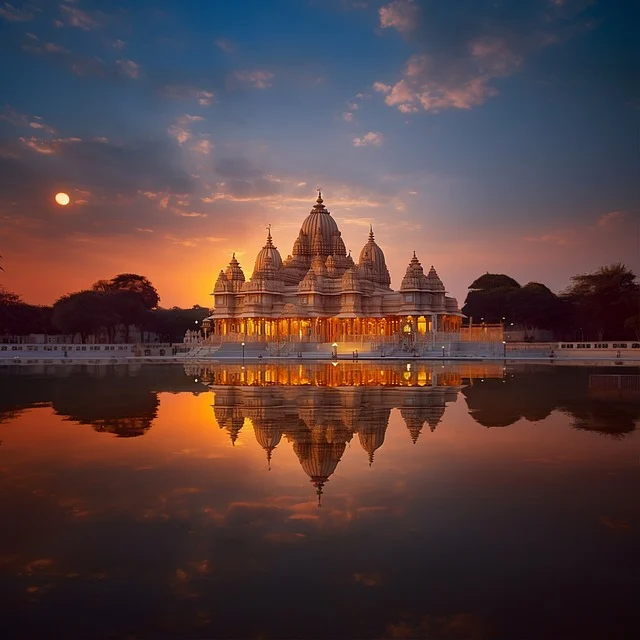
Photo of Ayodhya Ram Mandir
In this blog will discuss the special features of Ayodhya Ram Mandir Temple, let’s explore the uniqueness of Ayodhya Ram Mandir together.
Ayodhya Ram Mandir Area and Capacity
The Ayodhya Ram Mandir spread across the land of 2.7 acres and the temple premises is situated around 57,400 sq. ft. of land. The length of the Ayodhya Ram Mandir is 380 feet (From East to West), the width of the temple is 250 feet, and the height of the Ayodhya Ram Mandir is 161 feet. In the 3-storied Ram Mandir, the height of each floor is 20 feet and has 12 gates.
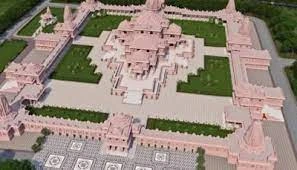
Photo of Ayodhya Ram Mandir: Image Credit Google
On daily basis around 50,000 devotees visit the Ayodhya Ram Mandir to worship Shri Ram. It is proposed that later the size of the devotees should be increased from 50,000 to 1 lakh on daily basis.
Ayodhya Ram Mandir Infrastructure
The 3 storied Ram Mandir has 392 pillars and 44 doors, the temple has ramps and lifts for the disabled person and elderly people. In the infrastructure of Ayodhya Ram Mandir neither steel nor iron was used, the temple has been made with the use of stone, wood, copper, and white cement. The bricks used in the infrastructure of Ayodhya Ram Mandir has a name of Shri Ram in each brick.
The doors and windows of Ayodhya Ram Mandir was made of Teek (Sagwan) wood, which was brought from Chandrapur, Maharashtra. The special wood will last till 100 years without any damage.
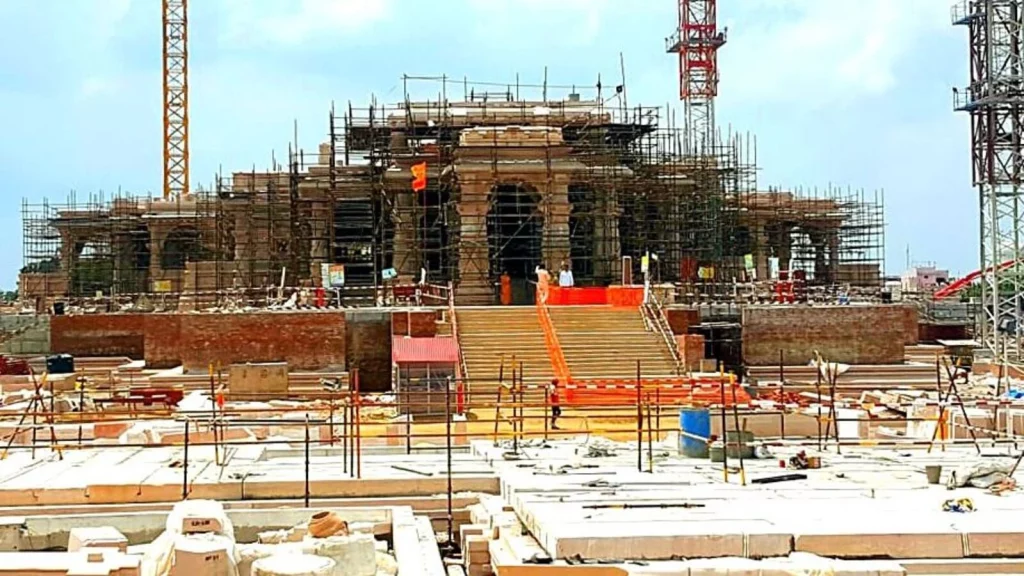
Photo of Ayodhya Ram Mandir: Image Credit Google
The whole Ayodhya Ram Mandir structure is prepared with the Pink Marbel which was shipped from Rajasthan. The rare pink marble and red stone is found in the Bayana, Bharatpur District of Rajasthan. The Bansi Paharpur Sandstone was used in Akshardham Temple, Lal Quila of Agra and the Parliamentary House.
Ayodhya Ram Mandir Chief Architecture
The Ayodhya Ram Mandir is designed by the Chief Architect Chandrakant Bhai Sompura, earlier his Grandfather Prabhakar Sompura along-with his son Ashish Sompura had designed the famous Somnath Mandir of Gujarat.
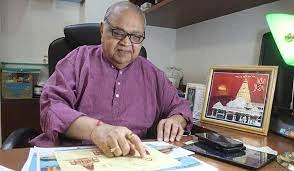
Photo of Chief Architect of Ayodhya Ram Mandir: Image Credit Google
The IIT Chennai people worked closely with the design and material of the Ayodhya Ram Mandir. The final testing was done by the Larsen & Turbo (L&T) and Tata Capital, and the structure is built in a manner that the Ayodhya Ram Mandir will last above 1000 years.
Other Unique Features of Ayodhya Ram Mandir
- The Time Capsule placed 2000 feet below the ground of Ayodhya Ram Mandir. The purpose of Time Capsule is to protect the identity of the temple, so that our future generations doesn’t forget our culture.
- The structure of Garbh-Grih is prepared in such a way that the ray of sun directly falls in the idol of Shri Ram (Ram Lalla).
- The idols of Shri Ram, Mata Sita, Shri Lakshman and Lord Hanuman is prepared by Arun Yogiraj and the colour of idols are in black.
- The 108 ft. incense stick is prepared by Vihabhai Bharwad who is based at Vadodara Rajasthan. The incense stick used in Ayodhya Ram Mandir will burn till 45 days or can say 1.5 months.
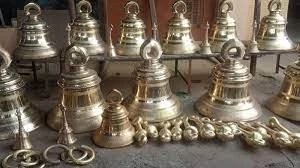
Photo of Bells in Ayodhya Ram Mandir: Image Credit Google
- The 42 bells (Ghantiyan) has a weight of 12000 kg and each bell has a different weight of 120 kg, 70 kg and 25 kgs. The bells are prepared in Chennai Tamil Nadu by R. Rajendran, owner of Andal Modelling Works. Before reaching Ayodhya, the puja was organized at Nammakal Anjaneyar Temple of Tamil Nadu. From here the bells will be shipped at Bangalore, and then the Bells (Ghantiyan) delivered at Ayodhya, Uttar Pradesh.
- The Parkota (rectangular compound wall) surrounds the temple. Within the temples of Lord Surya, Goddess Bhagwati, Lord Shiva, and Lord Ganesha located at each of the corners.
- An ancient Shiva Temple has been restored in southern part of the complex, and a well (Sita Koop) is located nearby.
- A gold plated Nagada weighs 500 kg was prepared in Gujarat and reach Ayodhya Dham for the Ram Temple Ceremony.
- Lata Mangeshkar Chowk was constructed at Ayodhya Dham and Vidan – Musical Instrument was placed in the Ayodhya.
How to book Prashad Online
- Go to the website khadiorganic.com, and at the home page, you will get option of “Get Your Free Prashad”.
- Click the button, and fill in the required details, like your contact details.
- In the Delivery section, there are two delivery options. First “Delivery to your doorstep for Just Rs.51/-) and second is “Pick up from your distribution centre (Free)”.
- If you choose 1st option, write your shipping address and pay only the delivery charges.
How to Reach Ayodhya Ram Mandir
- Nearest Airport: Ayodhya Airport is the nearest airport in Ayodhya. You can book taxi, cab or auto to reach Ayodhya Ram Mandir.
- Nearest Railway Station: Ayodhya Dham Junction. Ayodhya Ram Mandir is around 6-8 kms aways from the Ayodhya Dham Junction. You can book taxi, cab, auto & rickshaw which are easily available.
- By Road: Ayodhya is well connected with the major cities and buses are easily available.
Final Thought
Ayodhya Ram Mandir is an emotion of Santani and understanding the uniqueness of Ayodhya Ram Mandir delights us. With the help of this blog, I hope you understand everything about Ayodhya Ram Mandir. Everyone wants to reach Ayodhya for the ceremony, but it’s not possible and can create chaos. The government officials make sure that the Prashad of Ram Mandir reached to each person with the help of website, khadiorganic.com. With the help of website both national and international citizens can avail the Prashad of Ayodhya Ram Mandir. Jai Shri Ram…
Pack your bag and explore the unexplored places with Hema….

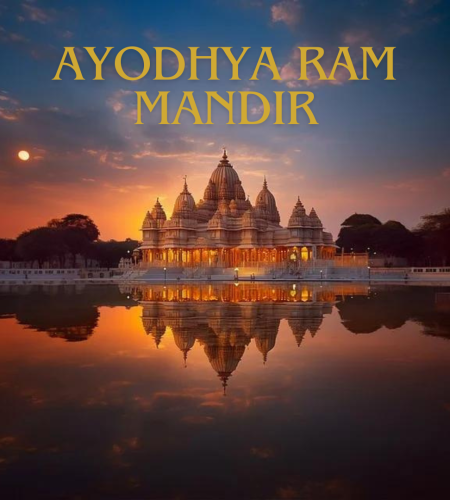
Each sentence builds on the last, creating a sense of momentum that makes it impossible to stop reading.
Your words resonate with a truth that feels universal — as though they’ve tapped into something deeply human.